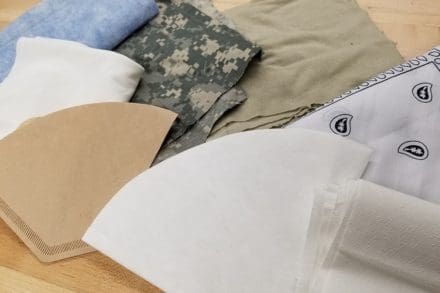
Aberdeen Proving Ground, Md. — Now that the Centers for Disease Control and Prevention, the Department of Defense, and many governors are recommending that people wear face coverings when out in public and unable to maintain proper social distancing, the Combat Capabilities Development Command (CCDC) Chemical Biological Center is using its more than 100 years of experience designing chemical and biological agent protective masks to determine the best material to use for making a homemade mask.
Over the last month, the Center has been contacted by more than 30 defense agencies, federal agencies and health organizations to see if its experts can help with the national shortage of personal protective equipment (PPE). The Center is one of only a handful of agencies that is experienced in performing tests that precisely measure materials’ filtration efficiencies in strict accordance with National Institute for Occupational Safety and Health (NIOSH) standards. It is also one of a very few organizations that have the Model 8130 Automated Filter Tester, which is no longer in production. So the Center was the obvious choice to perform this research.
“The challenge is to pick a material that effectively blocks the virus particles from going through the material while not being too hard to breathe through,” said David Caretti, chief of the Center’s Chemical Biological Protection & Decontamination Division and leader of the team testing homemade face covering materials. “If the resistance is too high, airflow will simply bypass the covering and go around the edges.”
“We knew that claims about masks and face coverings were exploding all over the internet, and we wanted to make sure that any decisions about materials these agencies make will be based on proven science,” said Caretti.
The Center performs its testing by spraying a salt aerosol at a swatch of material. The suspended salt particles are 0.2 to 0.3 microns in size, which is the hardest size for any material to filter, which is why that size is used in testing. The corona virus is 0.125 microns, making it a very close match. The testing team simply measures the density of salt aerosol suspended in the air on one side and compared it to the density on the other side after it passes through the material.
The team started out by testing materials sent to them by organizations seeking their expertise, then broadened out to testing materials likely to be found in the home that members of the public could use to make their own face coverings.
They found that the best readily available material to use in a homemade face covering is four-ply microfiber cloth which can be found in the cleaning section of most big box stores. It filters out over 75 percent of particles. In comparison, the N95 mask used by healthcare workers in hospitals can filter 90 percent of particles. The team also found that even a polyester bandanna can be reasonably effective if it is used in layers. It will filter out 40 percent of suspended particles.
Thus far, the Center has tested more than 50 materials and continues to test new materials. Armed with this information, the Center is now able to give other agencies the best filtration efficiency information possible for them to pass on to their stakeholders.
By CCDC Chemical Biological Center


“The suspended salt particles are 0.2 to 0.3 microns in size, which is the hardest size for any material to filter, which is why that size is used in testing. The corona virus is 0.125 microns, making it a very close match.” To say a 0.3 micron filter is a close match to filter out 0.125 virus is akin to saying if someone owes you $300 you’ll take only $125 in payment because it is a “close match.”
Don’t let perfect be the enemy of good. I cant make an N95 mask with my sewing machine…
I think they are referring to 4-ply shop cloths (blue rags) but its not clear. I’ve seen this before in academic testing that the shop cloths are the best / cheapest inserts for a cloth mask with filter pocket.
This is a false analogy because it doesn’t consider the actual filtering mechanism. N95 masks don’t work like your typical mesh filter for larger objects like sand. They rely on particles sticking to the fibers, not to them getting stuck between the fibers. Usually, when this mechanism is explained, the analogy with shooting in the forest is used. Indeed, the distance between the trees is by several orders of magnitude larger than a bullet size. But can you shoot as far as in the open field? No. I’d say, that it’s not a perfect analogy either. Flying a model airplane through the forest would be a bit more accurate. Most likely, you will end up crashing it into the branch, even though it can turn and fits between the branches easily.